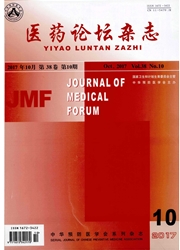

 中文摘要:
中文摘要:
目的探讨ST段抬高急性心急梗死(STEMI)患者心肌缺血分级对患者心律失常的影响。方法选取2009年6月~2011年5月未行溶栓治疗的STEMI患者76例,按心电图缺血分级分为Ⅱ级缺血组(36例)与Ⅲ级缺血组(40例)。比较两组患者入院时及溶栓2h后心电图ST段的变化,统计并比较室性早搏、室性心动过速或室颤、窦性停博及Ⅱ度或Ⅲ度房室传导阻滞等严重心律失常的发生率。结果患者人院时,Ⅱ级缺血组ST段抬高程度[(0.45±0.26)mVl明显低于Ⅲ级缺血组[(0.81±0.33)mV],差异有统计学意义(t=5.242,P〈0.05);Ⅲ级缺血组肌酸激酶同工酶(CK—MB)峰值[(370±67)U/L]高于Ⅱ级缺血组f(215±61)U/L],差异有统计学意义(f=9.343,P〈0.05)。溶栓治疗2h后,Ⅱ级缺血组ST段抬高程度[(0.23±0.11)mVl、ST段回降一半及以上比例[80.6%(29/36)1、CK—MB峰值[(227±58)U/L]均优于Ⅲ级缺血组[(0.49±0.17)mV、57.5%(23/40)、(358±94)U/L1,差异有统计学意义(P〈0.05)。Ⅱ级缺血组与Ⅲ级缺血组在室性早搏f8_3%(3/36)、12.5%(5/40)1、室性心动过速或室颤[2.8%(1/36)、7.5%(3/40)]、窦性停博[0.0(0/36)、2.5%(1/40)]及1I度或Ⅲ度房室传导阻滞f2.8%(1/36)、5.0%(5/40)]等严重心律失常的发生率比较,均无统计学意义(P〉0.05)。Logistic回归分析结果显示,入院时心电图ST段抬高程度、发病至溶栓时间及Ⅲ级缺血是STEMI患者发生严重心律失常的独立危险因素(P〈0.05)。结论缺血分级对ST段抬高急性心急梗死患者心律失常具有预测价值。
 英文摘要:
英文摘要:
Objective To investigate the influence of ischemia classification for arrhythmia in patients with ST-segment elevation acute myocardial infarction (STEMI). Methods 76 cases of STEMI patients from June 2009 to May 2011 were selected and divided into grade Ⅱ ischemia group (36 cases) and grade m ischemia group (40 cases) through the ischemic electrocardiographic grade. ECG ST-segment changes were compared on admission and 2 hours after the thrombolysis in the two groups. The incidence of serious arrhythmias including premature ventricualr contraction, ventricular tachycardia or ventricular fibrillation, sinus arrest and Ⅱ or m degree atrioventricular block were recorded and compared. Results The degree of ST-segment elevation in grade 11 ischemia group [(0.45±0.26) mV] was lower than that in grade 11[ ischemia group [(0.81±0.33) mV] when patients admitted to hospital, the difference was statistically significant (t = 5.242, P 〈 0.05); peak value of CK-MB in Ⅲ ischemia group [(370±67) U/L] was higher than that in I1 ischemia group [(215±61) U/L] when patients admitted to hospital, the difference was statistical- ly significant (t = 9.343, P 〈 0.05). The degree of ST-segment elevation, ST segment proportion of falling back half or more, peak value of CK-MB in grade I1 ischemia group 2 hours after the thrombolysis [(0.23±0.11) mV, 80.6% (29/ 36), (227±58) U/L] wei'e all better than those in grade HI ischemia group [(0.49±0.17) mV, 57.5% (23/40), (358±94) U/L], the differences were statistically significant (P 〈 0.05). The differences of incidence of premature ventricualr con- traction [8.3%(3/36), 12.5%(5/40)], ventricular taehycardia or ventricular fibrillation [2.8%(1/36), 7.5%(3/40)], sinus arrest [0.0(0/36), 2.5%(1/40)] and Ⅱ or m degree atrioventrieular block [2.8%(1/36), 5.0%(5/40)] were not statistically significant (P 〉 0.05). The degree of ST-segment elevation, the time from disease to
 同期刊论文项目
同期刊论文项目
 同项目期刊论文
同项目期刊论文
 Effect of Tumor Necrosis Factor-alpha on Neutralization of Ventricular Fibrillation in Rats with Acu
Effect of Tumor Necrosis Factor-alpha on Neutralization of Ventricular Fibrillation in Rats with Acu 期刊信息
期刊信息
